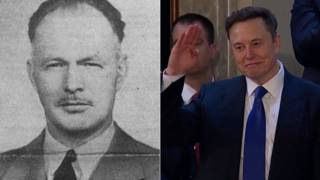
Guests
- Dr. Atul Gawandeassociate professor at Harvard School of Public Health and is a practicing surgeon at the Brigham and Women’s Hospital in Boston. He’s also a staff writer at The New Yorker magazine. He is the author of three books; the most recent is The Checklist Manifesto: How to Get Things Right.
The physical and psychological effects experienced by people held for extended periods in solitary confinement is a topic Dr. Atul Gawande has written extensively about. Yesterday, four prisoners in the supermax Ohio State Penitentiary launched a hunger strike to protest being held for more than 17 years years in solitary confinement. The alleged WikiLeaks whistleblower, U.S. Army Private Bradley Manning, has also been held in solitary confinement for much of the past seven months. “People experience solitary confinement as even more damaging than physical torture,” says Dr. Gawande. [includes rush transcript]
Transcript
SHARIF ABDEL KOUDDOUS: I want to switch gears for a moment. You wrote a remarkable piece about the effects of solitary confinement on prisoners, on people who have been held in isolation for a long time. On this issue, I just want to turn to the case of the four prisoners in a supermax prison, the Ohio State Penitentiary. This week they launched a hunger strike to protest what they call their harsh mistreatment under solitary confinement. The prisoners — Bomani Shakur, Siddique Abdullah Hasan, Jason Robb and Namir Abdul Mateen — were sentenced to death for their involvement in the 1993 prison uprising in Lucasville, Ohio. For over 17 years, they’ve been held in 23-hours-a-day solitary lockdown. On Monday, the four began refusing to eat meals until they are moved out of solitary confinement and onto death row, where they say they’ll get better treatment. Yesterday I spoke — Amy spoke with the longtime peace activist, historian and lawyer, Staughton Lynd. He wrote the definitive history of the 1993 Ohio prison uprising at Lucasville. He described the prisoners’ conditions. Let’s take a listen.
STAUGHTON LYND: They are held in more restrictive confinement than the more than 100 other death sentence prisoners in the same prison. Now, why is this? It’s precisely because the system thinks of them as leaders. So, it will let them watch television. They even let Bomani Shakur use a typewriter. But what they don’t let any of the four men do is to be in the same space as another human being other than a guard at the same time. And this means that while other death sentence prisoners can wander about the pod, can have collective meals outside their cells, and especially can have semi-contact visits with their friends and families, the four are always obliged to encounter the world either through a solid cell door or, when they go out on a visit, through a solid pane of glass. So that, again, Bomani has a niece and nephew aged eight and three that he loves and would wish to touch. If he were on death row, he could do that. But he’s been told by the prison authorities he will never be on death row, because they’re going to keep him in social isolation until they kill him.
AMY GOODMAN: So, that is Staughton Lynd, the longtime peace activist, lawyer, talking about these four men who have now gone on a hunger strike at the Ohio State Penitentiary, demanding to be put on death row, where they say that they will be treated better.
And then we’ve got the case of the alleged WikiLeaks Army whistleblower Bradley Manning, who’s being held in solitary confinement. Twenty-two years old, U.S. Army private, arrested in May, has been in detention ever since. For the past five months, he’s been held at the U.S. Marine brig at Quantico, Virginia, before that, held for two months in a military jail in Kuwait. Last month, we spoke to Glenn Greenwald, the political and legal blogger at Salon.com. Glenn reported that Manning is being held under conditions that constitute cruel and inhumane treatment, and even torture. This is what Glenn Greenwald said.
GLENN GREENWALD: He’s been held for seven months without being convicted of any crime. And the conditions that I recently discovered he’s being held in are really quite disturbing. And this has been true for the entire seven-month duration of his detention. He is in solitary confinement, and he’s not only in solitary confinement, which means that he’s in a cell alone, but he’s there for 23 out of 24 hours every day. He is released for one hour a day only. So, 23 out of the 24 hours a day he sits alone. He is barred from even doing things like exercising inside of his cell. He’s constantly supervised and monitored, and if he does that, he’s told immediately to stop. There are very strict rules about what he’s even allowed to do inside the cell. Beyond that, he’s being denied just the most basic attributes of civilized imprisonment, such as a pillow and sheets, and has been denied that without explanation for the entire duration of his visit, as well. And there is a lot of literature and a lot of psychological studies, and even studies done by the U.S. military, that show that prolonged solitary confinement, which is something that the United States does almost more than any other country in the Western world, of the type to which Manning is subjected, can have a very long-term psychological damage, including driving people to insanity and the like. It clearly is cruel and unusual; it’s arguably a form of torture. And given that Manning has never been convicted of anything, unlike the convicts at supermaxes to whom this treatment is normally applied, it’s particularly egregious.
SHARIF ABDEL KOUDDOUS: That’s Glenn Greenwald, the political and legal blogger at Salon.com. In his piece that he wrote about Manning, he actually cited your article “Hellhole,” which you document what happens to people held in isolation. Explain why this is thought of as a form of torture in many places.
DR. ATUL GAWANDE: Well, I was interested in whether it really was torture, and I was interested because this has become, I think, a generationally defining question for us. In the 1980s, during the Reagan administration, solitary confinement was very unusual. Today, we have over 50,000 people in long-term solitary confinement in our American prisons now. You know, in states like New York —- it’s across every -— red and blue states. We have — New York has over eight percent of its prison population in long-term solitary confinement. A large proportion — some think a majority — are not there for violent offenses, either. It’s a method of control that we regard as increasingly routine. And so, what my puzzle was, is it torture, or is it not?
And what I looked back to was the experience and the literature, which is much richer, around what hostages and prisoners of war — our Vietnam veterans, for example — experienced when they went through solitary confinement. And what’s found is that people experience solitary confinement as even more damaging than physical torture. Vietnam veterans who received physical torture — John McCain had two-and-a-half years in solitary confinement, had his legs and arm broken during his imprisonment, but described the two-and-a-half years that he spent in solitary as being the most cruel component and the most terrifying aspect of what he went under. You also look at studies that show that people held in isolation from other human beings —- we actually need social, friendly interaction with other people to be sane, to be absolutely -—
SHARIF ABDEL KOUDDOUS: Right. You document how people actually reach a level of psychosis.
DR. ATUL GAWANDE: That’s right. Not everybody.
SHARIF ABDEL KOUDDOUS: They begin to lose their minds, right?
DR. ATUL GAWANDE: Not everybody. The people who become psychotic in solitary confinement are people who often have attention deficit disorder or low IQ or issues of prior mental illness. Well, guess who is in our prisons? And there’s a very high rate of psychosis and people flat-out going crazy under the confinement conditions. And so, then what I puzzle over is, does it actually reduce our violence in our prisons? The evidence from multiple studies now is that not only that it has not reduced violence, it’s increased the costs of being in prison. And my finding was that we have decided that when it is political — when it is a prisoner of war or a hostage, that it is absolutely torture when other countries do this to people, and that there is no discernible difference in the experience of what people go through in our prisons, when they’re in solitary confinement for 14 years, in the case of one person who I documented, that this is torture.












Media Options